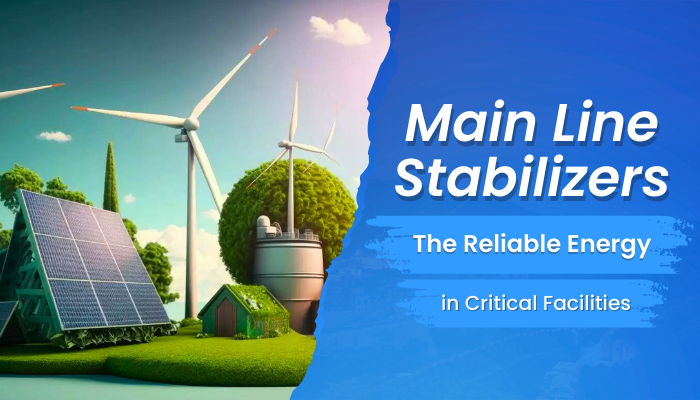The importance of uninterrupted power cannot be overstated, especially in critical facilities like hospitals, data centres, and industrial plants. But, have you ever wondered what keeps the power so steady and reliable in these places, even when the rest of us face blackouts? The hero behind the scenes is often the main line stabilizer. Designed to ensure that these essential services keep running without a hitch, these stabilizers are indeed the backbone of reliable energy.
What Are Main Line Stabilizers?
Main line stabilizers, including those expertly crafted by servo stabilizer manufacturers, are advanced electrical devices engineered to ensure a consistent voltage supply to various equipment and facilities. These devices are essential in environments where power fluctuations are common and can lead to equipment damage, data loss, or operational downtime. By automatically adjusting the voltage to a stable and safe level, main line stabilizers protect sensitive equipment and ensure seamless operations. Manufacturers specializing in servo stabilizers design these units to offer precise voltage control, making them particularly valuable in scenarios requiring the utmost accuracy and reliability in power supply regulation.
The Role of Main Line Stabilizers in Critical Facilities
Critical facilities like hospitals, data centers, and manufacturing plants require a stable and uninterrupted power supply to maintain operations. These facilities rely on main line stabilizers for several reasons:
Protection Against Power Fluctuations: Power surges or drops can cause irreparable damage to sensitive equipment. Stabilizers ensure that the voltage remains within safe limits.
Preventing Data Loss: In data centers, even a brief power interruption can lead to significant data loss. Stabilizers provide a stable power supply that mitigates this risk.
Ensuring Operational Continuity: For hospitals and emergency services, power reliability is non-negotiable. Stabilizers ensure that these critical operations continue without interruption.
How Do Main Line Stabilizers Work?
Main line stabilizers use a combination of transformers and control circuitry to adjust incoming voltage to a stable and predetermined level. The process involves:
Detection of Voltage Fluctuations: The stabilizer continuously monitors the incoming power supply for any deviations from the desired voltage level.
Automatic Correction: Once a fluctuation is detected, the stabilizer’s circuit activates transformers to adjust the voltage up or down to the required level.
Continuous Monitoring: This process happens in real-time, with the stabilizer constantly adjusting and monitoring the voltage to ensure it remains stable.
Types of Main Line Stabilizers
There are several types of main line stabilizers, each suited to different applications and load requirements:
Servo-Controlled Stabilizers: These stabilizers use a servo motor to control the transformer, providing precise voltage correction. They are ideal for facilities with highly sensitive equipment.
Static Stabilizers: Without moving parts, static stabilizers use electronic circuitry to stabilize voltage. They offer fast response times and are suitable for data centres.
Relay Based Stabilizers: These are more economical and used in environments where high precision is not as critical. They are commonly found in residential and small office settings.
Choosing the Right Stabilizer for Your Facility
Choosing the right main line stabilizer hinges on understanding your facility’s needs, including equipment sensitivity, facility size, and local voltage stability. High-precision equipment demands stabilizers with tight voltage regulation, while larger facilities might need higher capacity or multiple units for adequate coverage. In areas with significant electrical fluctuations, stabilizers with quick response times are essential.
Consulting a power solutions expert is invaluable; they can assess your specific requirements and recommend the most suitable stabilizer type, ensuring your infrastructure is protected and power efficiency optimized. Leveraging professional advice tailors your solution to both operational needs and budget, safeguarding your critical operations effectively.
Conclusion: The Shield Against Power Instability
Main line stabilizers are indispensable in ensuring the reliability of power in critical facilities. By safeguarding sensitive equipment from voltage fluctuations, they play a crucial role in maintaining operational continuity, protecting data, and preventing equipment damage. As our reliance on technology grows, the importance of these stabilizers in our infrastructure cannot be understated.
FAQs
Can main line stabilizers save energy?
While their primary function is to stabilize voltage, not to save energy, they can indirectly contribute to energy efficiency by preventing wastage and reducing the need for repairs and replacements due to equipment damage.
How often do main line stabilizers need maintenance?
The maintenance requirements depend on the type of stabilizer and the environment in which it operates. Servo-controlled stabilizers, for example, may require more frequent checks due to their moving parts.
Can I install a main line stabilizer myself?
It’s recommended that installation is done by a professional, especially for large or complex systems, to ensure safety and optimal performance.
By understanding the critical role of main line stabilizers and selecting the appropriate type for your needs, you can ensure a stable and reliable power supply for your critical operations.


